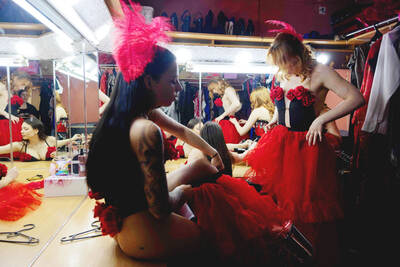Alison Bechdel's Fun Home: A Family Tragicomic is an engrossing memoir that does the graphic novel format proud. The tale -- about Bechdel's childhood, her father's death and their shared homosexuality -- is painfully honest and richly detailed in words and images.
At its heart Fun Home captures Bechdel yearning to connect with her father, Bruce Allen Bechdel. In the opening chapter, Old Father, Old Artificer, parent and child are playing a game of "airplane" that ends almost as soon as it begins. The sight of a filthy rug and loose molding ends the brief lull from her father's obsessive restoration of the family's Victorian home.
Her father "could spin garbage into gold" and "cultivate the barren yard into a lush, flowering landscape," Bechdel writes and draws, but he was so emotionally distant that, even before his death, she "ached as if he were already gone."

With the dramatic personae established, the subsequent chapters depict pivotal events in the family's history. Along the way we learn that Bruce Allen Bechdel was a part-time English teacher and a third-generation funeral director. (Fun Home is what the children called the building where he practiced his trade.)
Despite -- or perhaps because of -- growing up around the rituals of mourning, Bechdel recalls the stunted reaction to her father's death: "Dry-eyed and sheepish, my brothers and I looked for as long as we sensed it was appropriate. If only they made smelling salts to induce grief-stricken swoons, rather than snap you out of them."
The death was deemed an accident -- a truck hit him as he crossed a road with an armful of garden brush -- but Bechdel suspects suicide. The timeline she supplies makes a reasonable case. Four months before the fatal day she informed her parents that she was a lesbian. Her mother countered with news about her husband's affairs with men. Two weeks before Bechdel's death, his wife asked for a divorce. "If I had not felt compelled to share my little sexual discovery," Bechdel writes, "perhaps the semi would have passed without incident."
There are some feelings of guilt in that statement, but also a grasp at connection. Where father and daughter had the strongest relationship was in books, whether in discussing them or using them as tools of seduction. Her father invited his "more promising high school students" -- the muscular, male ones, it seems -- to visit his home to
borrow copies of great American novels like The Sun Also Rises and The Great Gatsby. Later, as part of her "dawning feminism," Bechdel recalls a private, erotic reading of James and the Giant Peach. The Bechdels are closest when she is the only student in his English class who does not seem consumed by lethargy.
Literature also plays a large role in Bechdel's self-discovery. "My realization at 19 that I was a lesbian came about in a manner consistent with my bookish upbringing," she writes. That statement is part of an electric two-page sequence in which the author, after discovering books about gay people, takes the first tentative steps toward coming out.
Throughout the memoir, but most especially here, the magic of the graphic format emerges. Bechdel's qualms, trepidation and excitement emerge from the words and images working together. Somehow combining the two ingredients conveys more than either one could do alone.
That incredible alchemy is clearly evident and most effectively used in Chapter Five, The Canary-Colored Caravan of Death. A caption describes Bechdel's home as an artists' colony. The image shows the family in the house, with each member in his or her own bubble of solitude, writing, playing the guitar or doing restoration work. These pages also chronicle the beginning, at age 10, of the author's obsessive-compulsive disorder, which, on the good side, helped her become such a metic-ulous archivist of her life.
Here again the images enhance the text. We see the number of edges of flooring Bechdel felt compelled to count before she could cross a threshold. Or how, doubting her own diary, she obsessively began adding the phrase "I think" to each sentence. (To save time, "I think" eventually became a symbol that she would add to whole pages of the journal.)
With a closeted father in the house, perhaps it was natural to doubt the truth. At 13, Bechdel gets a hint of her father's secret when he confides that he has been ordered by the court to see a psychiatrist. His reason is simply: "I'm bad. Not good like you."
The mandated six months of counseling hints at a more serious offense than the official charge of offering beer to a minor in his car. The most direct communication father and daughter shared is recalled in a particularly powerful two-page sequence. On a ride to a movie theater, eyes never leaving the road, Bechdel's father tentatively talks about his sexual experiences. She feels a surge of connection, but the moment passes all too soon.
The bittersweet relationship of parent and child is conveyed again and again in Fun Home. Fittingly, the memoir ends with two images that echo the bad times and the good. The top half of the final page shows the truck about to strike; the bottom half depicts daughter, in mid-leap, waiting to be caught in her father's arms. The juxta-position of the two images is compelling and striking. They also offer reader and author a choice: appreciate what was had or continue to yearn. In completing Fun Home Bechdel may have finally ended her longing.

The canonical shot of an East Asian city is a night skyline studded with towering apartment and office buildings, bright with neon and plastic signage, a landscape of energy and modernity. Another classic image is the same city seen from above, in which identical apartment towers march across the city, spilling out over nearby geography, like stylized soldiers colonizing new territory in a board game. Densely populated dynamic conurbations of money, technological innovation and convenience, it is hard to see the cities of East Asia as what they truly are: necropolises. Why is this? The East Asian development model, with

June 16 to June 22 The following flyer appeared on the streets of Hsinchu on June 12, 1895: “Taipei has already fallen to the Japanese barbarians, who have brought great misery to our land and people. We heard that the Japanese occupiers will tax our gardens, our houses, our bodies, and even our chickens, dogs, cows and pigs. They wear their hair wild, carve their teeth, tattoo their foreheads, wear strange clothes and speak a strange language. How can we be ruled by such people?” Posted by civilian militia leader Wu Tang-hsing (吳湯興), it was a call to arms to retake

This is a deeply unsettling period in Taiwan. Uncertainties are everywhere while everyone waits for a small army of other shoes to drop on nearly every front. During challenging times, interesting political changes can happen, yet all three major political parties are beset with scandals, strife and self-inflicted wounds. As the ruling party, the Democratic Progressive Party (DPP) is held accountable for not only the challenges to the party, but also the nation. Taiwan is geopolitically and economically under threat. Domestically, the administration is under siege by the opposition-controlled legislature and growing discontent with what opponents characterize as arrogant, autocratic

When Lisa, 20, laces into her ultra-high heels for her shift at a strip club in Ukraine’s Kharkiv, she knows that aside from dancing, she will have to comfort traumatized soldiers. Since Russia’s 2022 invasion, exhausted troops are the main clientele of the Flash Dancers club in the center of the northeastern city, just 20 kilometers from Russian forces. For some customers, it provides an “escape” from the war, said Valerya Zavatska — a 25-year-old law graduate who runs the club with her mother, an ex-dancer. But many are not there just for the show. They “want to talk about what hurts,” she